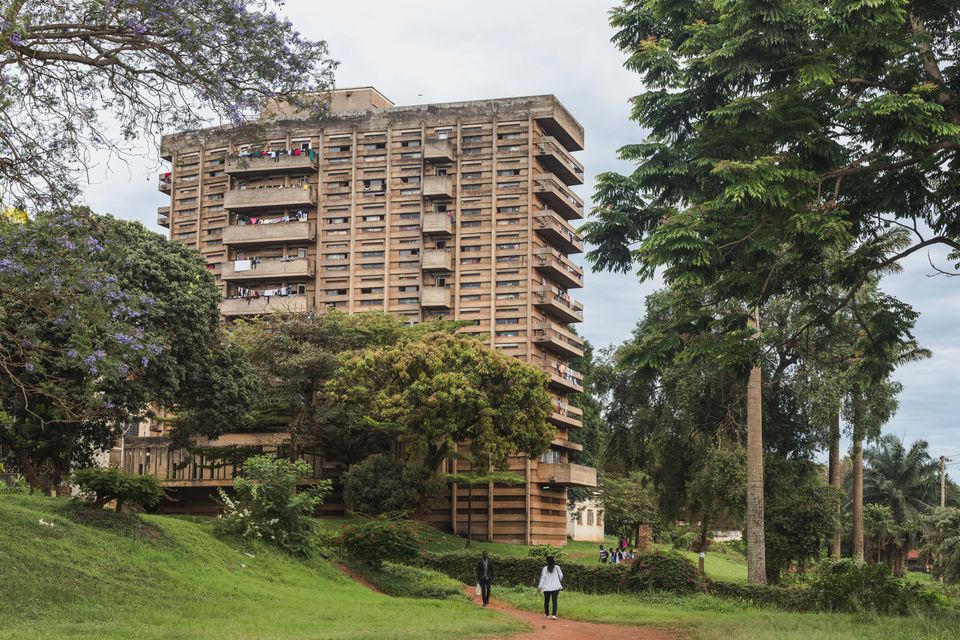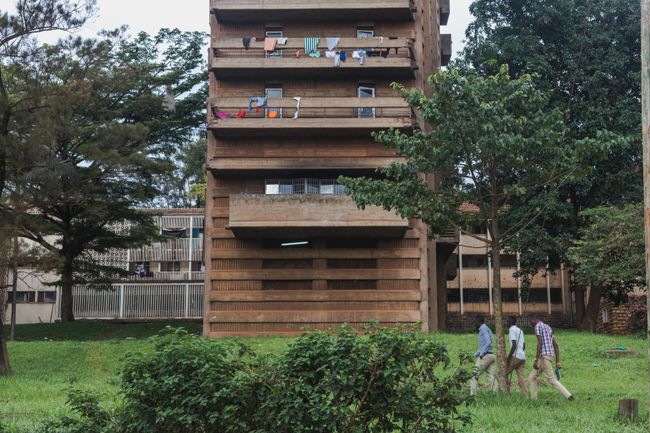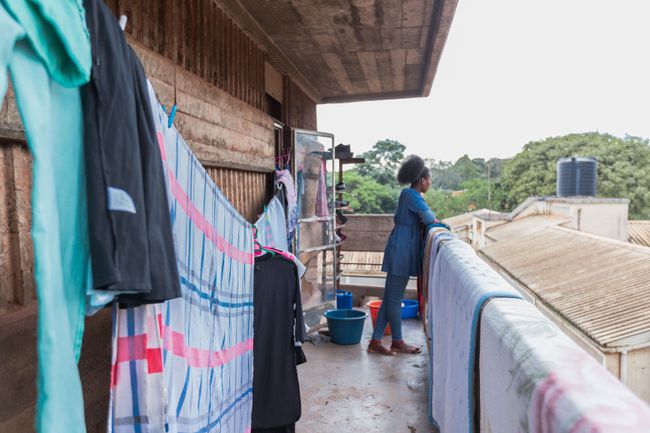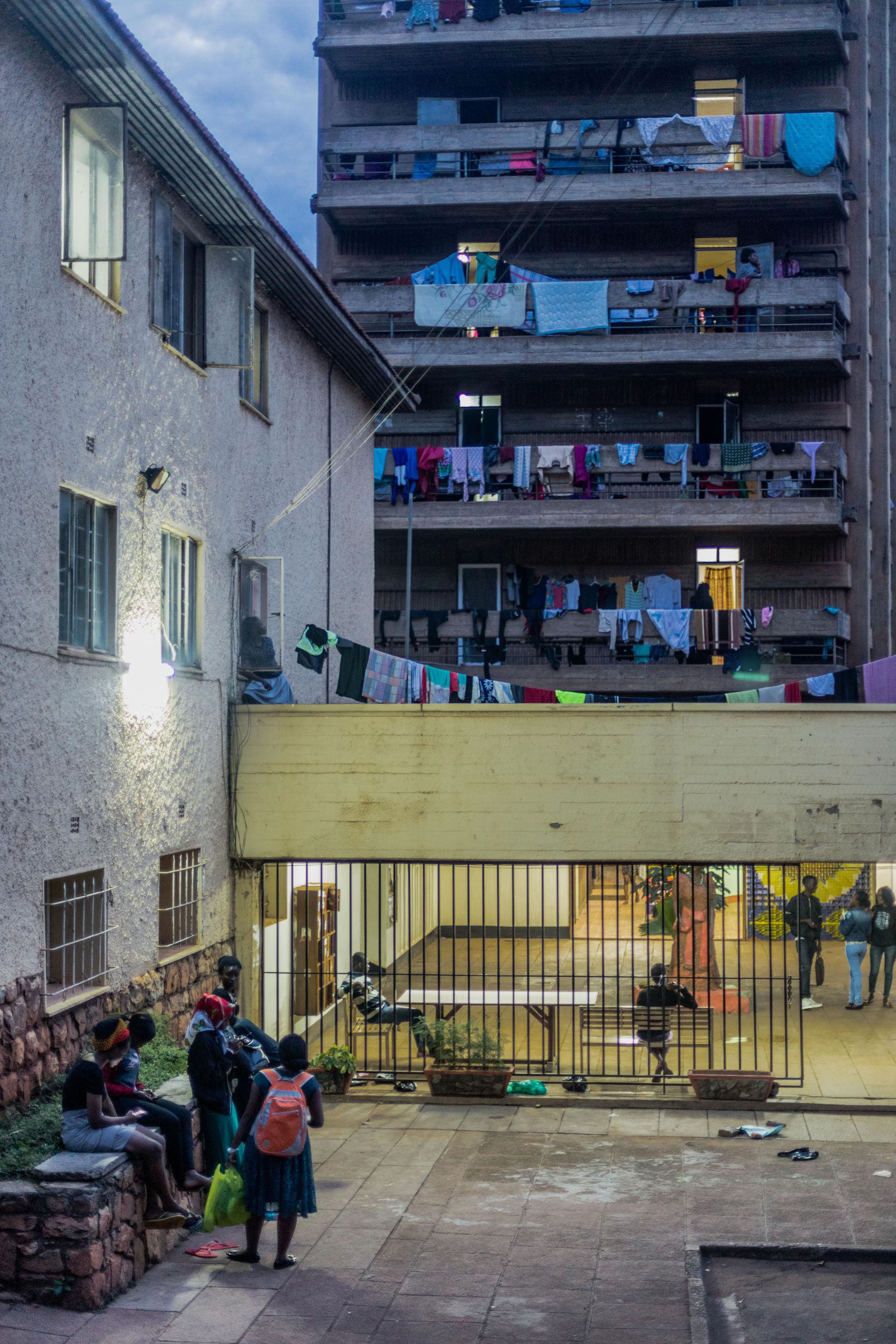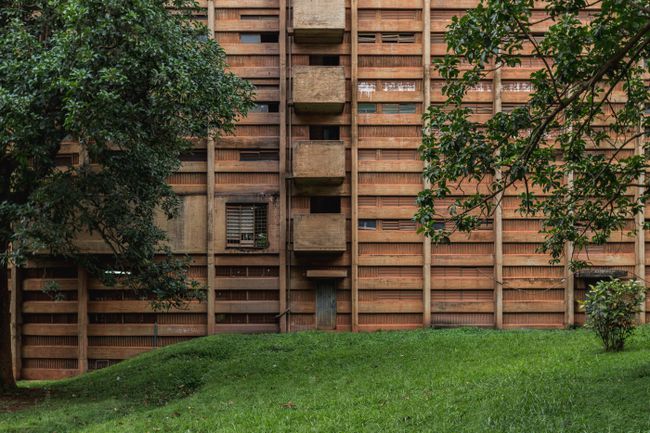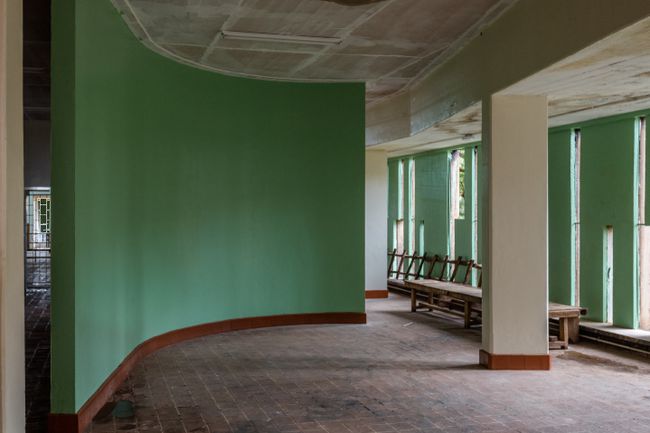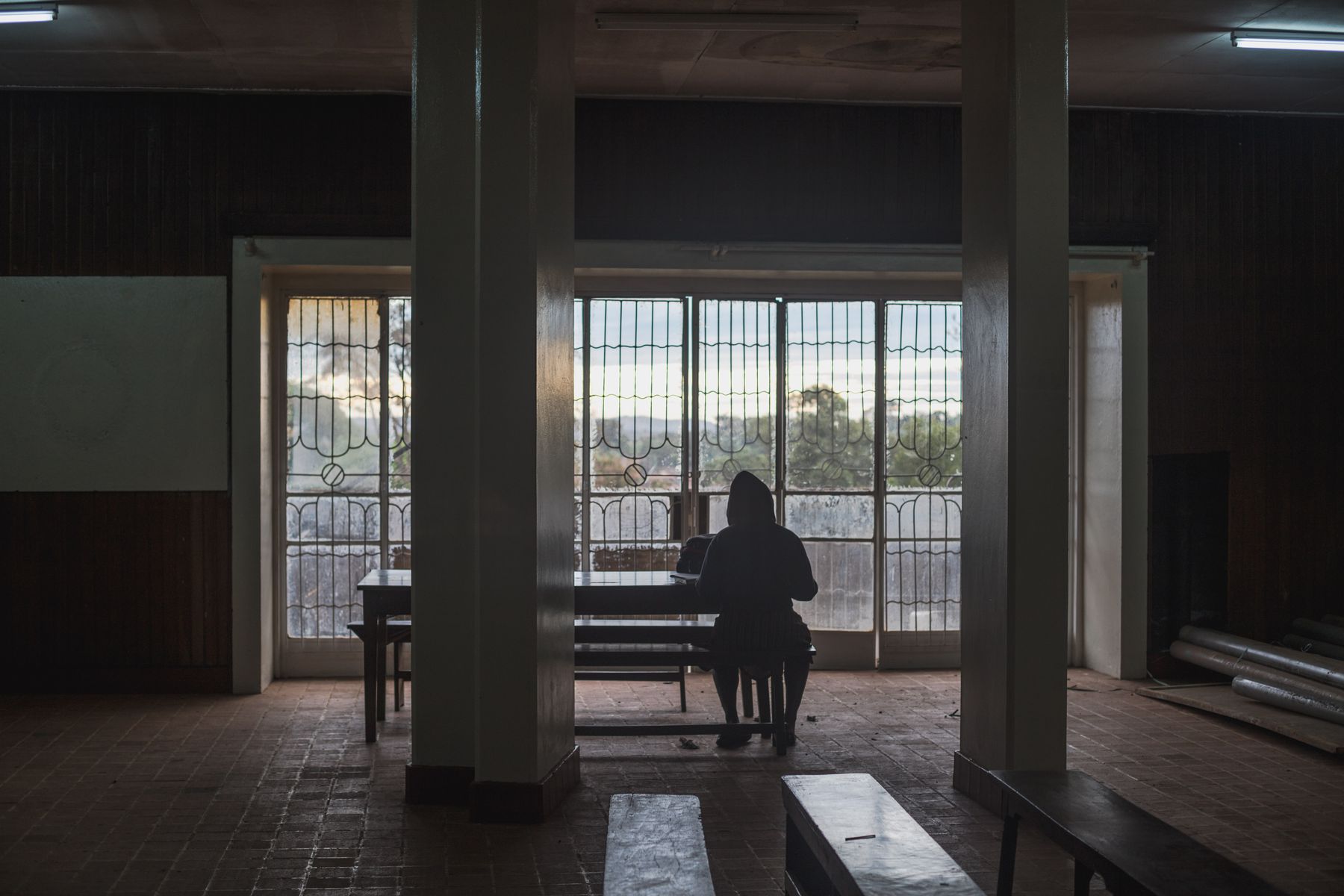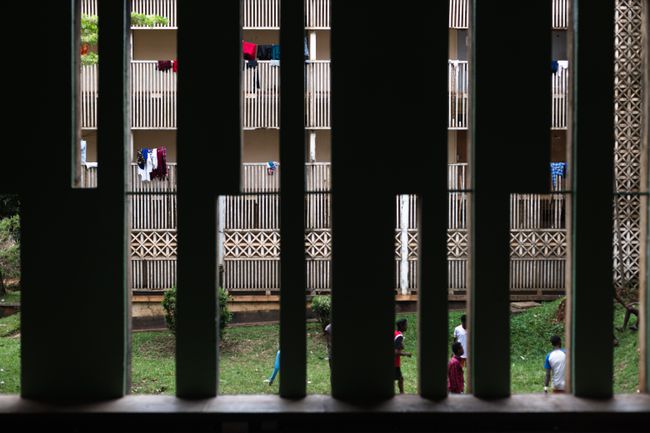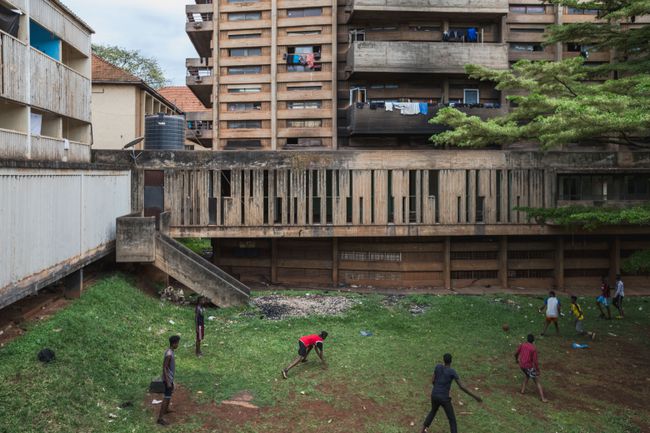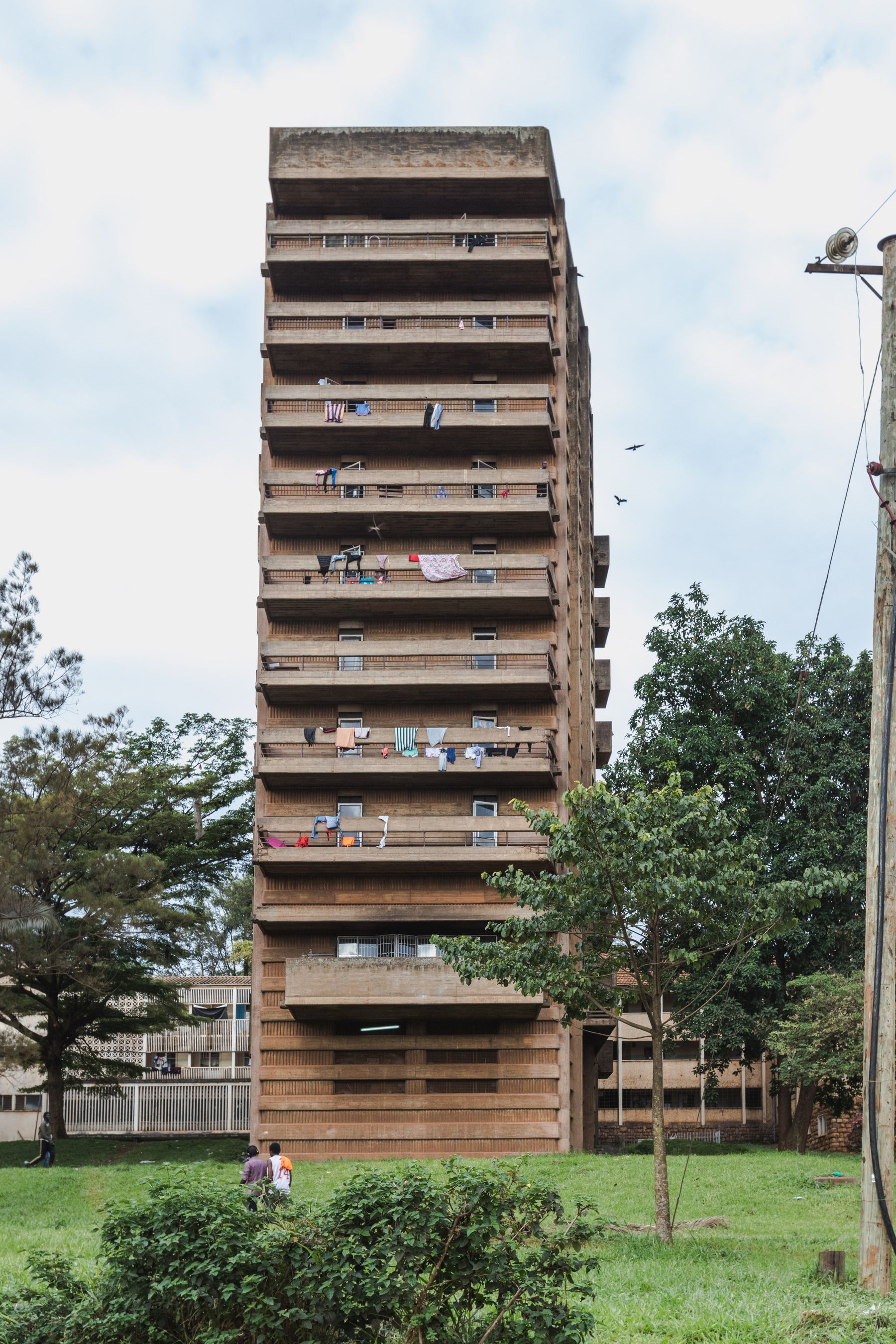Building Mary Stuart Hall
Doreen Adengo traces the story of a brutalist dormitory. Photographs by Timothy Latim
Known as the Harvard of Africa, Makerere University in Kampala, Uganda, is one of the oldest institutions of higher learning in East and Central Africa. Generations of prominent Africans—including presidents of Kenya and Tanzania—have been educated at the university since it was first opened as a technical school in 1922. Beginning with just fourteen boys and five instructors, the British Protectorate government (1894–1962) started the school in an effort to address the lack of artisans in its East African territories following World War I.1 Over time, the colonial institution was first transformed into a college for higher education for East and Central Africa in 1940, then into the University of East Africa in 1963, and finally, in 1970, into Makerere University.
The technical school was established at the bottom of Makerere Hill with two temporary workshops for carpentry and mechanics and a temporary dormitory for the fourteen male students. A surveying course was introduced in 1923, followed by engineering and agriculture. Once the institution became a regional college in 1940, under the stewardship of Governor Sir Phillip Mitchel, it acquired more land and an endowment to expand. Despite the ongoing Second World War, the government secured the funding to commission new buildings, notably the Main Building and the twin chapels—St. Augustine for the Roman Catholics and St. Francis for the Anglicans—, which were completed in 1941.2
The initial slogan of the technical school was ”Let’s be Men,” in reference to the men who had been trained to build the campus itself. In his 1922 annual report, H.O. Saville, an engineer in the protectorate government and the first principal of the technical school, wrote:
It is our boast that the whole of the buildings so far completed are entirely the work of natives of the Protectorate, working under the direction of the European instructors, no foreign skilled labour has been employed in any part of the buildings. It is to be hoped that we may be able to complete our building programme without departing from this principle.3
However, in 1945, the slogan was changed to “We Build For the Future,” which suggested looking beyond the bricks and mortar of the technical school and aligning with the idea of a new college whose role was to build for the next generations and for the country as a whole.4
-
John Ssebuwufu, Managing and Transforming an African University (Dakar: CODESRIA, 2017), 60, https://carnegie.codesria.org//wp-content/uploads/2018/01/Managing-and-Transforming-an-African-University.pdf. ↩
-
Margaret MacPherson, They Built for the Future: A Chronicle of Makerere University College 1922–1962 (Cambridge: Cambridge University Press, 1964), ix. ↩
-
H.O. Saville, quoted in MacPherson, They Built for the Future, xi. ↩
-
Macpherson, ix. ↩
The First Women of Makerere College
1945 was also the year that Makerere College first admitted female students, after a long struggle spearheaded by Mary Stuart, the wife of Anglican Archbishop Simon Stuart, and after the first women’s warden had travelled throughout East Africa to find women qualified to pursue higher education.1 It was difficult to find female students because there were predominantly only boys’ schools in Uganda. Kings College Budo (a primary and secondary school in Kampala founded in 1906) had admitted a few girls into its kindergarten class in 1933 and a woman Inspector of Schools was hired in 1934 with the expectation that girls’ education would consistently improve.2 But even though there were over one-hundred girls qualified to enter secondary school education in 1938, there still weren’t the girl’s schools available to take them in.3 As a result, it was a slow process to educate enough girls in order to substantially increase the enrolment of women to Makerere College. To begin with, the college would only enrol female students in courses such as tailoring and home economics, but by 1955 it awarded the first Bachelor of Arts degree to a woman.4 A few women who passed through Makerere College stand out as pioneers in creating opportunity for Ugandan girls to pursue higher education.
Sarah Nyendwoha Ntiro (1926–2018) was one of the first six female students admitted to Makerere College. Previously, as a girl at King’s College Budo, she had excelled in mathematics but was advised to pursue her education in knitting and tailoring. She instead opted for history, geography, and English and received a teaching certificate. While teaching at Kyebambe Girls School in 1950, Ntiro also studied Latin with clergymen based in Bunyoro-Kitara Kingdom, in Western Uganda, and passed the proficiency test at the Virika Mission in Fort Portal, earning her admission to St. Anne’s College at the University of Oxford, England. She returned to Uganda in 1954 as the first woman in East and Central Africa to earn a Bachelor of History from Oxford.5 The following year, Ntiro became a high school teacher but, despite having the same qualifications as her male counterparts, was paid a lower salary than male tutors by the colonial government. Instead of accepting this sexist policy, Ntiro took a radical stance, rejecting the salary and teaching without pay. The wife of the then Governor later intervened and Ntiro’s salary was made commensurate to that of her colleagues.6 Ntiro went on to work in the office of the Vice-Chancellor, Makerere University between 1970 and 1978 and she was recognized as ”Woman of Distinction” by the Forum of African Women Educationalists Uganda in 2000.
In 1955, the same period in which Ntiro was fighting for equal pay, Eunice Lubega Posnansky (1927–2003) became the first Ugandan woman to obtain a bachelor’s degree from Makerere College (she had previously been among the first Ugandan girls to graduate from high school at King’s College Budo).7 And like Ntiro, Posnansky went on to study at the University of Oxford, returning to Uganda to teach Luganda, music, history, and geography to high school students. In 1965, she became the first African president of the Uganda Association of University Women and director of Women’s Education. She then moved to Ghana in 1967 to work as an assistant librarian at the University of Ghana but emigrated to California just two years later where she worked for several libraries within the University of California Los Angeles and then taught for the Los Angeles Unified School District until retirement in 1994.8
And just four years after Posnansky obtained a Bachelor of Arts, Josephine Nambooze (1930–) became the first woman to receive a degree in medicine from Makerere College. She had passed the entrance exam with such high marks that she was admitted into the Faculty of Science, then to the Faculty of Medicine, and finally she qualified as the first female African doctor to graduate from Makerere.9
-
Joy Constance Kwesiga, “Access of Women to Higher Education in Uganda: An Analysis of Inequalities, Barriers and Determinants,” (PhD diss., University of London, 1993), 216, https://discovery.ucl.ac.uk/id/eprint/10006581/1/DX192671.pdf. ↩
-
MacPherson, They Built for the Future, 22. ↩
-
Kwesiga, “Access of Women to Higher Education in Uganda,” 216. ↩
-
MacPherson, They Built for the Future, 32. ↩
-
Aili Mari Tripp, Women and Power in Postconflict Africa (Cambridge: Cambridge University Press, 2015), 56. ↩
-
“Dr Sarah Ntiro, pioneer in education and women’s rights described as ‘a Ugandan Rosa Parks’,” Telegraph Obituaries, 13 November 2008, https://www.telegraph.co.uk/obituaries/2018/11/13/dr-sarah-ntiro-pioneer-education-womens-rights-described-ugandan/. ↩
-
Tripp, Women and Power in Postconflict Africa, 56. ↩
-
“Eunice Lubega Posnansky,” obituary, 12 October 2003, Los Angeles Times, https://www.legacy.com/us/obituaries/latimes/name/eunice-posnansky-obituary?id=27627461. ↩
-
MacPherson, They Built for the Future, 62. ↩
The First Women’s Dormitory
According to Mary Stuart, British administrators were not in favour of women pursuing higher education and that the principal was outwardly hostile toward both the new students and the first warden of the women’s residence. When women were first admitted to Makerere College, they were not allowed in the junior common room and were initially barred from taking part in the activities of the students’ guild.1 Furthermore, these women lived in an administrative building that was adapted for residential accommodations. As early as 1938, funds had been approved by local authorities to build a women’s dormitory at Makerere College, but the offer was never taken up.
However, by the late 1940s, there was clearly an urgent need to expand accommodation facilities for female students. And yet, the first women’s hall of residence, completed in 1953, was built for a maximum of forty occupants, demonstrating the enrolment expectations of the Makerere College planners. By 1958 there were ninety women enrolled, so an extension was completed the following year (designed by Nairobi-based Blackburne, Norburn and Partners) that included an expanded dining hall and a new wing, a junior common room, and a small set of rooms for research students.2
As the number of female students increased more rapidly in the 1960s, the then University of East Africa was under pressure to build yet another extension to Mary Stuart Hall. This extension would be part of a plan for the development of Makerere Hill that would accommodate a university of two thousand students and allow for fifty years of growth.3 The plan, known as the Kendall Plan, had been drawn up by the Kampala town planner at the request of the college in 1955. At the time, the college principal noted there was already “an excellent nucleus of university buildings that compare worthily with those of United Kingdom,” but that he was not satisfied with the architecture styles used in design or with the knowledge of academic needs applied to campus planning.4
Building the Concrete Tower
It is within this context that Peatfield and Bodgner, a British architecture practice based in Kampala, were commissioned to design the extension to Mary Stuart Hall in 1965. Thomas Peatfield and Geoffrey Bodgener had formed their practice in 1952, after having studied together in London, served together in the Royal Air Force in World War II, and even been schoolmates. Like many of their peers, Peatfield and Bodgener looked for potential projects in the network of countries then emerging from British colonial rule.1 In 1956, they entered, and won, a Commonwealth architecture competition for a national assembly building in Uganda with a design proposal that evolved into a project for the future Parliament. This project paved the way for Peatfield and Bodgener, who were well positioned to win commissions given the lack of trained architects in Uganda at the time (the nearest architecture school was in Nairobi).2 In addition to Mary Stuart Hall, they went on to design, among others, the Bank of Uganda headquarters (1966), the Uganda Commercial Bank (now Cham Tower) (1976), and the Uganda House (1980).
Initially, Peatfield and Bodgener proposed different design schemes of two or three storeys for Mary Stuart Hall, but because of the growing number of female students, the architects eventually developed a proposal for an eight-storey tower that included individual rooms, a common room and dining room, a warden’s office, and a library. The foundations were poured in 1965 and construction was completed in 1972. The tower, a testament to brutalism, was built by an Israeli company, Solel Boneh, using cast-in-place concrete with a rough finish, two elevator shafts, and cantilevered balconies. The company was one of several Israeli contractors active in Uganda at the time, responsible for implementing projects ranging from roads to airports, housing estates, water infrastructure, agricultural stations, and public buildings. The relationship between Uganda and Israel began to develop in the late 1950s and was further cultivated in the 1960s as Israel invested extensive effort and resources in the economies and infrastructure of newly independent East African countries.3 Solel Boneh built several significant modernist architecture projects such as Peatfield and Bodgener’s Uganda Commercial Bank building and the expansive Bugolobi Flats (1971).4 Regardless of whether Peatfield and Bodgener had won the commission for Mary Stuart Hall tower, building their ambitious design depended on a contractor experienced in working with concrete at such a scale.
-
Ben Flatman, “An architect’s guide to surviving the rule of Idi Amin,” Building Design., 7 July 2017 https://www.bdonline.co.uk/opinion/an-architects-guide-to-surviving-the-rule-of-idi-amin/5088622.article. ↩
-
Flatman, “An architect’s guide to surviving the rule of Idi Amin.” ↩
-
Arye Oded, “Israeli-Ugandan Relations in the Time of Idi Amin,” Jewish Political Studies Review 18, no. ¾ (Fall 2006): 66, https://www.jstor.org/stable/25834697. ↩
-
“The Start of Uganda Commercial Bank,” New Vision, 3 December 2019, https://www.newvision.co.ug/news/1511549/start-uganda-commercial-bank. Solel Boneh began construction of the Uganda Commercial Bank began in 1969, but their contract was terminated by Idi Amin in 1972. Construction was completed in 1979 by Energo Company from the former Yugoslavia. ↩
The Demise of the Dorms
However, the material condition of Mary Stuart Hall tower deteriorated early on as circumstances at Makerere University started to change in the 1970s due to the fluctuating political situation. Ugandan President Idi Amin, who assumed power following a military coup in 1971, was initially in favour of working with the Israel government, only to quickly change his position and instead align himself with Arab governments. The political shift culminated on 30 March 1972 when Amin ordered the Israeli embassy in Uganda to close and ended diplomatic relations. Just one week later there were no Israelis left in Uganda.1 Ugandans also began leaving the country in large numbers, while Amin abruptly introduced a policy requiring clearance from the President’s office to travel outside the country. This meant that academics were no longer able to attend international conferences.2
Political instability made life at Mary Stuart Hall particularly uneasy, in part due to the lack of funds and the departure of foreign expertise for maintenance. In the 1970s for example, the elevator was permanently closed after it became stuck at the bottom of the shaft and the door-locking mechanism failed, such that a student fell to her death after opening the door to get into the elevator car.3 Throughout the 1970s more design issues with the tower became apparent, most notably the flat roofs that were inappropriate for the East African climate. Milton Obote, who was elected President for a second time in 1980 after Idi Amin was overthrown in 1979, allocated funding for the emergency rehabilitation of Makerere University dorms in 1982, which included pitching the flat roof of Mary Stuart Hall, along with those of other modernist buildings Lumumba Hall and Africa Hall. While the pitching helped, the aluminium sheets deteriorated after several years due to exposure to the elements.4
The 1980s continued to be a tumultuous period for Uganda, until 1986 when current President Yoweri Museveni came to power. It was under the new government that Makerere University commissioned Peatfield and Bodgener to renovate its dorms and that the firm’s current director, Philip Curtin, arrived in Kampala from the United Kingdom. He had applied for any job available at the Royal Institute of British Architects and ended up being offered a position with Peatfield and Bodgener in Kampala to work on the reconstruction and rehabilitation of Uganda’s deteriorating institutional buildings.5
-
Oded, “Israeli-Ugandan Relations in the Time of Idi Amin,” 74. ↩
-
Ssebuwufu, Managing and Transforming an African University, 73. ↩
-
Ssebuwufu, 75. ↩
-
Emily Wax, “Hard times for ‘Harvard of Africa’,” The Guardian, 18 November 2005, https://www.theguardian.com/theguardian/2005/nov/18/guardianweekly.guardianweekly1. ↩
-
Philip Curtin, interview with author, 27 May 2021. ↩
The Rehabilitation of the Dorms
Since the mid-1908s, the number of students has increased substantially at Makerere University, leading to overcrowding and mismanagement of its facilities. According to the administration, there were just over 5000 students enrolled in 1984, while today enrolment is in the range of 40,000.1 In particular, the number of women admitted has increased since Makerere University instituted an affirmative-action policy in 1990, in which 1.5 points are added to every application from a female student. Privatization and government funding cuts have also put pressure on the university to admit more paying students, all while it still cannot afford to expand its facilities.
As a result of overcrowding, the social spaces in Mary Stuart Hall have progressively been taken over by educational functions—the dining hall is now a lecture hall and the common room has been transformed into study rooms. This has left the dorm rooms as the only spaces where students can take their meals and socialize. On a typical floor of the tower there are rooms without balconies meant to accommodate one or two students that now house three or four. Another dorm type is a double room with a shared balcony that originally housed two or three students and is now occupied by five or six. In this congested condition, the shared balconies have become not only the only social spaces but also the only space available for domestic activities like eating or doing laundry. It is also from these balconies that the women have a view over the courtyards of Lumumba Hall, the men’s residence, a visual connection that has helped foster a solidarity between the two halls and led to various social effects to foster more student interaction.
Despite the physical prominence of Mary Stuart Hall, it remains insufficient to provide accommodation for all the women who study at Makerere University. As a result, there is an increasing number of hostels in the vicinity of the university to supplement dorm capacity. Certain hostels are private while others are affiliated with Makerere, meaning that university officials have reached an understanding with hostels to accommodate students off campus. And though some are more affordable, the hostels with better amenities and good security charge higher rents, often starting at twice the price of a room in a Makerere University residence.2 This network of hostels provides a necessary service, perhaps even of a better quality than what is offered on campus, but it also demonstrates that the supply of comfortable and safe accommodation for female students continues to be as precarious as it was before Mary Stuart Hall was built.
-
Wax, “Hard times for ‘Harvard of Africa’.” ↩
-
Jonah Kirabo, “Hostel Guide; All you need to know about MAK, MUBS hostels,” NilePost, 30 July 2018, https://nilepost.co.ug/2018/07/30/hostel-guide-all-you-need-to-know-about-mak-mubs-hostels/; Christopher Tusiime, “Inside Makerere’s Best Hostels, Their Prices and Facilities,” Journalism@mak, 29 May 2016, https://journalism.mak.ac.ug/?q=news/290516/inside-makereres-best-hostels-their-prices-and-facilities. ↩
The author would like to reiterate her gratitude to Professor Barnabas Nawangwe, Vice Chancellor of Makerere University; Dr. Allan Barabi, Senior Lecturer at the Department of Architecture and Physical Planning; Philip Curtin, director at Peatfield and Bodgener Architects; photographer Timothy Latim; and research assistant William Samuel Byangwa.
Doreen Adengo wrote this text as part of her research for the Multidisciplinary Research Project Centring Africa: Postcolonial Perspectives on Architecture.
